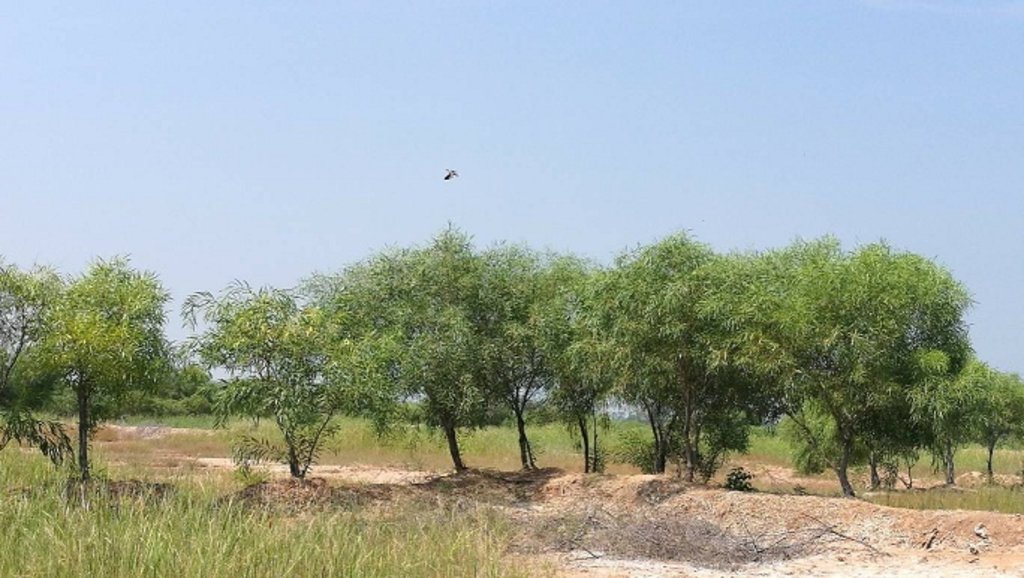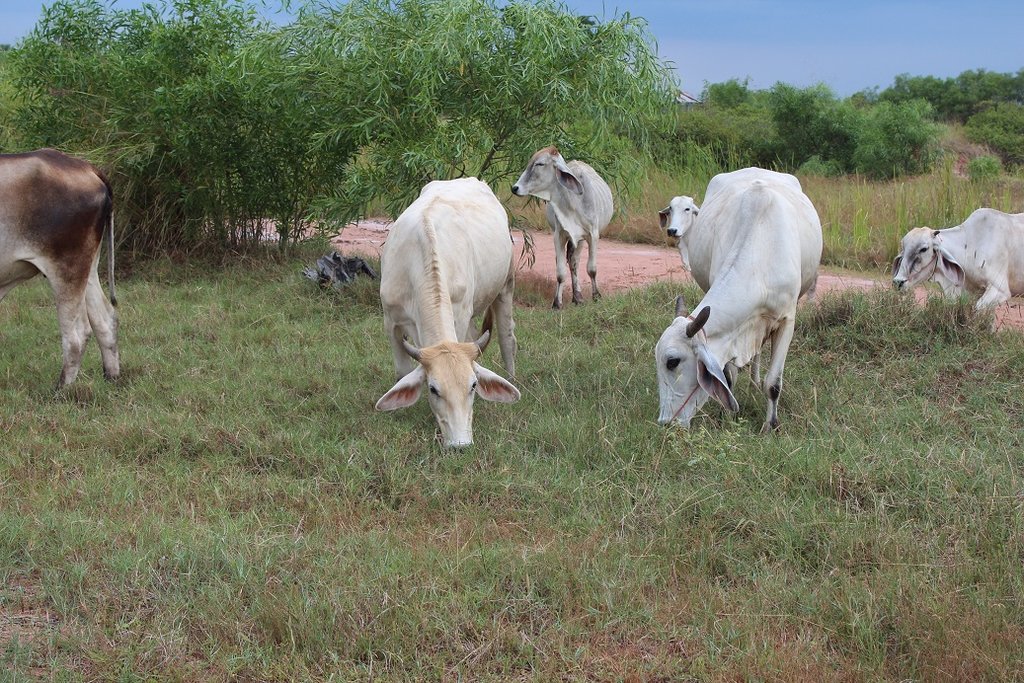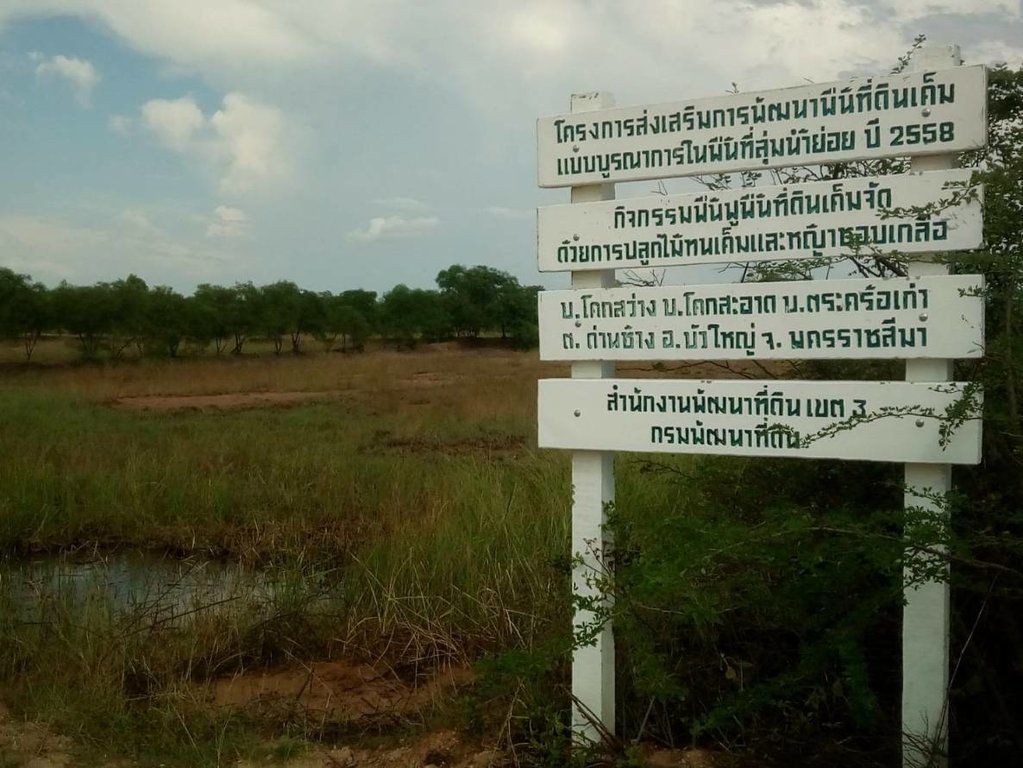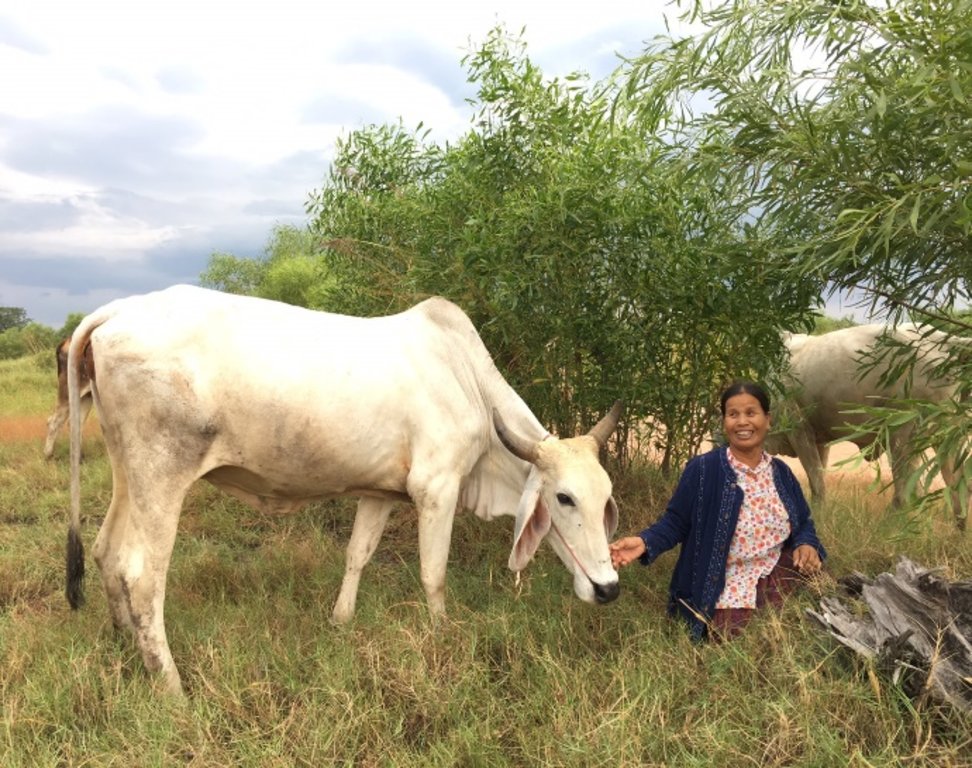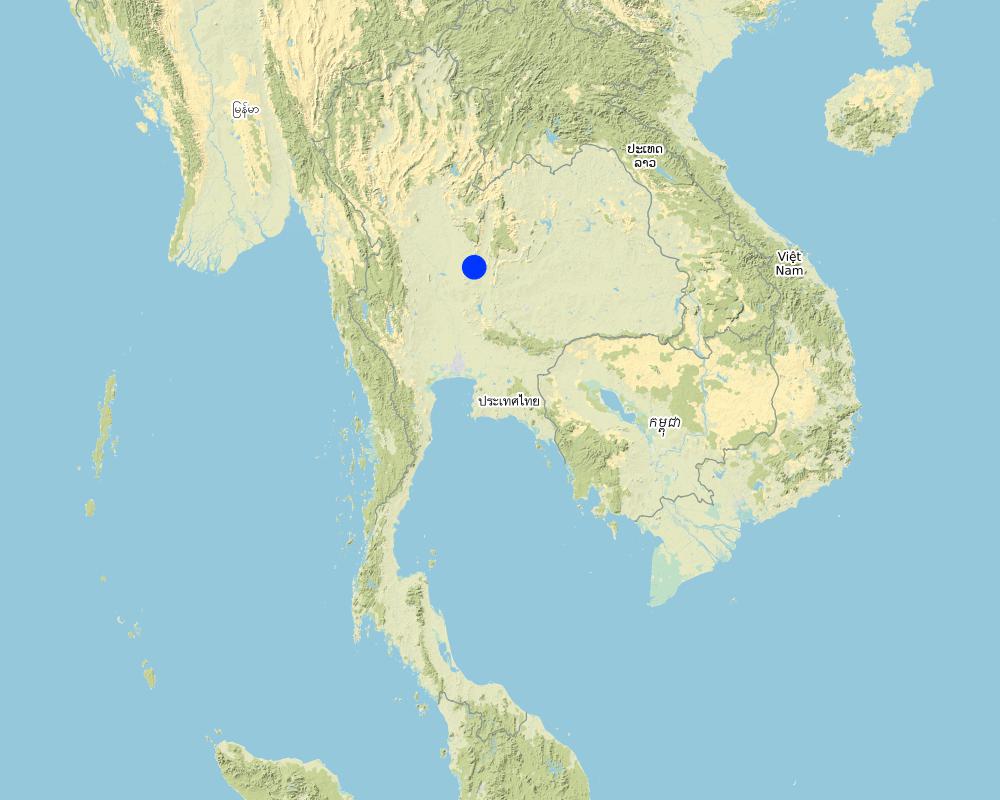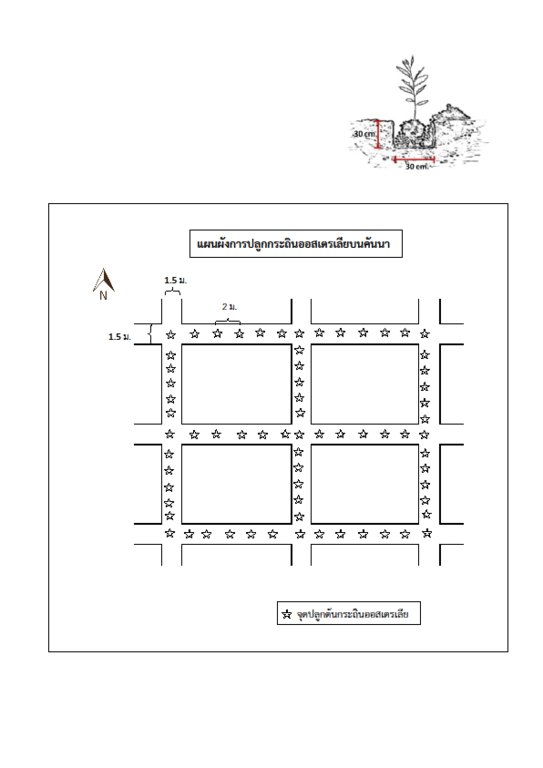Planting of Acacia ampliceps to control severely salt-affected land. [Thailand]
- Creation:
- Update:
- Compiler: Chakkaphan Phaosrakhu
- Editor: –
- Reviewers: Samran Sombatpanit, Rima Mekdaschi Studer, William Critchley
Planting Acacia ampliceps on severely salt-affected land leveled with ditches and dikes.
technologies_4149 - Thailand
View sections
Expand all Collapse all1. General information
1.2 Contact details of resource persons and institutions involved in the assessment and documentation of the Technology
Key resource person(s)
land user:
Tathaisong Nurean
-
Thailand
SLM specialist:
Phaosrakhu Chakkaphan
Land Development Regional Office 3
Thailand
SLM specialist:
Chuaysanoi Phatranit
Land Development Regional Office 3
Thailand
SLM specialist:
Oechaiyaphum Kaewjai
Land Development Regional Office 3
Thailand
SLM specialist:
Prachansri Saowanee
Land Development Regional Office 3
Thailand
SLM specialist:
Phiprakon Apisit
Land Development Regional Office 3
Thailand
SLM specialist:
Prawanna Prasit
Land Development Regional Office 3
Thailand
National consultant:
Name of project which facilitated the documentation/ evaluation of the Technology (if relevant)
Decision Support for Mainstreaming and Scaling out Sustainable Land Management (GEF-FAO / DS-SLM)Name of the institution(s) which facilitated the documentation/ evaluation of the Technology (if relevant)
Land Development Department (Land Development Department) - Thailand1.3 Conditions regarding the use of data documented through WOCAT
The compiler and key resource person(s) accept the conditions regarding the use of data documented through WOCAT:
Ja
1.4 Declaration on sustainability of the described Technology
Is the Technology described here problematic with regard to land degradation, so that it cannot be declared a sustainable land management technology?
Nee
Comments:
The technology is very well accepted by the land users.
2. Description of the SLM Technology
2.1 Short description of the Technology
Definition of the Technology:
Acacia ampliceps is a very salt-tolerant species that can grow well in severely salt-affected areas. Land leveling with ditches and dikes is needed, and they are planted along an east-west direction. The technology is very well accepted by land users.
2.2 Detailed description of the Technology
Description:
Acacia ampliceps (salt wattle, a leguminous Australian shrub), has been introduced in salt-affected areas in the Northeast of Thailand for the remediation of saline soils. It is a very salt-tolerant plant that grows well on severely salt-affected land. Leveling the land and furnishing with ditches and dikes is needed first, and then the trees are planted in the affected area, along an east-west orientation on the dikes. The technology is very well accepted by land users. Planting such trees in the severely salt-affected land in Kham Tale Sau, Nakhon Ratchasima Province is a subproject of the LDD project on "Planting Perennial Salt-tolerant Trees in Salt-affected Areas in the Northeast of Thailand", which started since 1997. In the subproject, Acacia ampliceps was grown on 68 rai (approx. 11 hectares) covering >50% of the salt patches in heavily salt-affected barren land owned by Mrs. Nurian Tathaisong at Ban Kok Sa-ad Village, Dansay Sub-district, Buayai District, Nakhon Ratchasima Province. In a recent study, after planting the acacia tree in 2015, her land had changed noticeably from its barren state to being covered with trees that provided shade; native grasses had returned to form a source of fodder for her 14 cattle. The purposes of the project have been to maximize the use of the land with a low level of inputs and to decrease salinity to the level that other less salt-tolerant plant species can survive - and crops can be grown for higher income. Eventually it is hoped that better soil properties will be created.
The technology started with locating severely salt-affected sites, leveling the land and furnishing it with ditches and dikes. Each dike is 2 m wide at its base, 0.5 m high, and 1.5 m wide on top. The ditch is 0.5 m deep and 1 m wide. Acacia ampliceps seeds are treated to break the dormancy by soaking in hot water (80°C) for 10 min before planting in the nursery. The 2-month-old seedlings are planted in pits of 0.3 x 0.3x 0.3 metres on the dike, with the addition of 1 kg each of compost and rice husks. Spacing between planting pits is 2 m as a single row in the middle of the dike. According to the land user, 1 year after planting native grasses had returned while the salt crusts had disappeared. At 2-years old, the average plant height was 1.65 m and continued growing, producing 8-10 coppices per tree, and leafy shade for cattle. Acacia ampliceps wood is used to produce charcoal. Three years after planting, the land user had converted 23 rai (approx. 3.7 hectares) of less saline land to paddy fields. After a period of 3 years, the technology induced a better microclimate and richer diversity of flora and fauna species, e.g. wild flowers, native grasses, frogs, dragonflies, earthworms, birds and rats. The fragrant Acacia ampliceps flowers attract bees, thus in the near future the land user intends to undertake apiculture as well as producing essential oil, and making charcoal. The only visible threat to Acacia ampliceps is a forest-fire risk due to its high oil content; fires could cause damage to crops.
2.3 Photos of the Technology
2.4 Videos of the Technology
Date:
28/11/2018
Date:
28/11/2018
2.5 Country/ region/ locations where the Technology has been applied and which are covered by this assessment
Country:
Thailand
Region/ State/ Province:
Nakhon Ratchasima
Further specification of location:
Ban Kok Sa-ard, Moo 10 T. Danchang, A. Buayai, Nakhon Ratchasima, Thailand
Specify the spread of the Technology:
- applied at specific points/ concentrated on a small area
Is/are the technology site(s) located in a permanently protected area?
Nee
Comments:
On farmer's land.
Map
×2.6 Date of implementation
Indicate year of implementation:
2015
If precise year is not known, indicate approximate date:
- less than 10 years ago (recently)
2.7 Introduction of the Technology
Specify how the Technology was introduced:
- through projects/ external interventions
Comments (type of project, etc.):
Land Development Department and Local authorities had demonstrated Acacia ampliceps plantation on farm ridges in the salt-affected area, under the project of salinity-tolerant crop plantation to suppress salt-affected soil distribution, at A. Buayai, Nakhon Ratchasima since 2014 up to now.
3. Classification of the SLM Technology
3.1 Main purpose(s) of the Technology
- reduce, prevent, restore land degradation
- conserve ecosystem
- preserve/ improve biodiversity
- Desalination
3.2 Current land use type(s) where the Technology is applied
Land use mixed within the same land unit:
Nee

Unproductive land
Specify:
Barren land
Remarks:
There are salt crusts in the heavily salt-affected barren land.
Comments:
Acacia ampliceps plantation on land leveled with ditches and ridges, had potential salinity watertable control.
3.3 Has land use changed due to the implementation of the Technology?
Has land use changed due to the implementation of the Technology?
- Yes (Please fill out the questions below with regard to the land use before implementation of the Technology)
Land use mixed within the same land unit:
Ja
Specify mixed land use (crops/ grazing/ trees):
- Agroforestry

Cropland

Unproductive land
3.4 Water supply
Water supply for the land on which the Technology is applied:
- rainfed
Comments:
Average annual rainfall 900-1,100 mm.
3.5 SLM group to which the Technology belongs
- improved ground/ vegetation cover
- desalination
3.6 SLM measures comprising the Technology

agronomic measures

vegetative measures
- V1: Tree and shrub cover

structural measures
- S1: Terraces

other measures
3.7 Main types of land degradation addressed by the Technology

chemical soil deterioration
- Cs: salinization/ alkalinization

physical soil deterioration
- Pc: compaction
- Pw: waterlogging

biological degradation
- Bc: reduction of vegetation cover
- Bq: quantity/ biomass decline
- Bl: loss of soil life

water degradation
- Hg: change in groundwater/aquifer level
3.8 Prevention, reduction, or restoration of land degradation
Specify the goal of the Technology with regard to land degradation:
- reduce land degradation
- adapt to land degradation
4. Technical specifications, implementation activities, inputs, and costs
4.1 Technical drawing of the Technology
Technical specifications (related to technical drawing):
The technologies start with locating severely salt-affected sites and land leveling with ditches and dikes. The dike is 2 m wide, 0.5 m high, the top of the dike is 1.5 m wide. The ditch is 0.5 m deep and 1 m wide. Acacia ampliceps seeds are treated to break the dormancy by soaking in 80°C hot water for 10 min before planting in the nursery. The 2-month-old seedlings are planted in a pit of 0.3x0.3x0.3 m on the dike, with an addition of 1 kg each of compost and rice husk, at a spacing of 2 m as a single row in the middle of the dike. The ridges are 20 m apart.
Author:
Chakkaphan Phaosrakhu
Date:
09/10/2018
4.2 General information regarding the calculation of inputs and costs
Specify how costs and inputs were calculated:
- per Technology area
Indicate size and area unit:
45 rai
If using a local area unit, indicate conversion factor to one hectare (e.g. 1 ha = 2.47 acres): 1 ha =:
1 ha = 6.25 rai
other/ national currency (specify):
THB
If relevant, indicate exchange rate from USD to local currency (e.g. 1 USD = 79.9 Brazilian Real): 1 USD =:
32.0
Indicate average wage cost of hired labour per day:
300 THB/day
4.3 Establishment activities
| Activity | Timing (season) | |
|---|---|---|
| 1. | Nursery of Acacia ampliceps. | May-July |
| 2. | Preparing the pit for planting | May-July |
| 3. | Planting Acacia ampliceps | May-July |
Comments:
There is no irrigation water, therefore planting time depends directly on the period of early rainy season which is May-July.
4.4 Costs and inputs needed for establishment
| Specify input | Unit | Quantity | Costs per Unit | Total costs per input | % of costs borne by land users | |
|---|---|---|---|---|---|---|
| Labour | Cost of hired labour on planting process (cost of hired labour/ day is 300 THB, 1 rai needs 2 labourers. Hence, the total cost of hired labour is 600 THB) | rai | 1.0 | 600.0 | 600.0 | |
| Plant material | Cost of Acacia ampliceps nursery (1 young seedling costs 1.50 THB). 1 rai needs 80 young seedlings. So, the total cost of young seedlings is 120 THB. | seedling | 80.0 | 1.5 | 120.0 | |
| Fertilizers and biocides | The cost of compost is 3.5 THB/kg. Rate of application is 0.5 kg/pit | kg | 40.0 | 3.5 | 140.0 | |
| Fertilizers and biocides | The cost of rice husk is 4 THB/kg. Rate of application is 1 kg/pit | kg | 80.0 | 4.0 | 320.0 | |
| Fertilizers and biocides | The cost of chemical fertilizer (15-15-15) is 20 THB/kg. Rate of application is 0.1 kg/pit | kg | 8.0 | 20.0 | 160.0 | |
| Total costs for establishment of the Technology | 1340.0 | |||||
| Total costs for establishment of the Technology in USD | 41.88 | |||||
If land user bore less than 100% of costs, indicate who covered the remaining costs:
-
Comments:
Land Development Department supports the operational budget particularly cost of Acacia ampliceps plantation, while land users are in charge of maintenance and forest fire control during dry seasons.
4.5 Maintenance/ recurrent activities
| Activity | Timing/ frequency | |
|---|---|---|
| 1. | Forage harvesting after 1 year of Acacia ampliceps plantation | rainy season, 4 times |
Comments:
After 1 year of planting, the native grasses that did not exist have returned while salt crusts disappear.
4.6 Costs and inputs needed for maintenance/ recurrent activities (per year)
| Specify input | Unit | Quantity | Costs per Unit | Total costs per input | % of costs borne by land users | |
|---|---|---|---|---|---|---|
| Labour | Cost of hired labour on trimming process: 1. The cost of hired labour: 300 THB/8-hr day and 2. Trimming process for 1 rai requires 4 hours each time, twice a year. Hence, the total cost of hired labour on trimming process is 300 THB/rai/yr) | time | 2.0 | 150.0 | 300.0 | 100.0 |
| Total costs for maintenance of the Technology | 300.0 | |||||
| Total costs for maintenance of the Technology in USD | 9.38 | |||||
Comments:
Land users operate trimming process; however, labour cost is calculated.
4.7 Most important factors affecting the costs
Describe the most determinate factors affecting the costs:
Land Development Department supports the operational budget particularly cost of Acacia ampliceps plantation at first year, then users are in charge of maintenance and forest fire control.
At the first year, the initial cost for Acacia ampliceps plantation is about 1,340 THB. This includes: the cost of hired labour on planting process, 600 THB/rai; the cost of young seedlings, approximately 120 THB/rai and the cost of compost, rice husk and chemical fertilizer, about 620 THB/rai. For the expenditure part on the 1st year, there is a hired labour for harvesting fodder in a period of 6 months, approximately 300 THB/rai (from the early to the end of rainy season). However, land user can produce fodder and have grazing land for 14 cattle for around 180 days/yr. Each cattle needs about 30 kg of fodder a day. The cost for the fodder is 1 THB/kg. Land user can save the cost for cattle feeding approx. 5,400 THB/cattle/yr. In conclusion, land user can save the cost for fodder production and grazing land approximately 1,680 THB/rai. For the expenditure part on 2nd and 3rd year, there is fodder harvesting, trimming process and charcoal production. Land users may obtain approx. 10 bags of charcoal that costs 120 THB/bag. Thus, there is a direct income from charcoal production (about 26.7 THB/rai/yr) and an increase of rice production (up to 5%). Land users can have increased income from selling rice at 100 THB/rai.
In conclusion, there is a cost of maintenance during 3 years for approx. 900 THB/rai. Part of the income, the land user can have income from the increased rice yield approx. 100 THB/rai/yr. Otherwise, charcoal production can reduce fuel’s expenditure in daily life for approx. 26.7 THB/rai/yr. Fodder production and grazing land can reduce cost of cattle feeding for approximately 1,680 THB/rai/yr. The land user, however, wants to leave the branches of Acacia ampliceps for watertable control and for cattle shading.
5. Natural and human environment
5.1 Climate
Annual rainfall
- < 250 mm
- 251-500 mm
- 501-750 mm
- 751-1,000 mm
- 1,001-1,500 mm
- 1,501-2,000 mm
- 2,001-3,000 mm
- 3,001-4,000 mm
- > 4,000 mm
Indicate the name of the reference meteorological station considered:
Meteorological Department
Agro-climatic zone
- semi-arid
5.2 Topography
Slopes on average:
- flat (0-2%)
- gentle (3-5%)
- moderate (6-10%)
- rolling (11-15%)
- hilly (16-30%)
- steep (31-60%)
- very steep (>60%)
Landforms:
- plateau/plains
- ridges
- mountain slopes
- hill slopes
- footslopes
- valley floors
Altitudinal zone:
- 0-100 m a.s.l.
- 101-500 m a.s.l.
- 501-1,000 m a.s.l.
- 1,001-1,500 m a.s.l.
- 1,501-2,000 m a.s.l.
- 2,001-2,500 m a.s.l.
- 2,501-3,000 m a.s.l.
- 3,001-4,000 m a.s.l.
- > 4,000 m a.s.l.
Indicate if the Technology is specifically applied in:
- not relevant
5.3 Soils
Soil depth on average:
- very shallow (0-20 cm)
- shallow (21-50 cm)
- moderately deep (51-80 cm)
- deep (81-120 cm)
- very deep (> 120 cm)
Soil texture (topsoil):
- medium (loamy, silty)
Soil texture (> 20 cm below surface):
- medium (loamy, silty)
Topsoil organic matter:
- low (<1%)
5.4 Water availability and quality
Ground water table:
5-50 m
Availability of surface water:
medium
Water quality (untreated):
for agricultural use only (irrigation)
5.5 Biodiversity
Species diversity:
- low
Habitat diversity:
- low
5.6 Characteristics of land users applying the Technology
Sedentary or nomadic:
- Sedentary
Market orientation of production system:
- mixed (subsistence/ commercial)
Off-farm income:
- 10-50% of all income
Relative level of wealth:
- average
Individuals or groups:
- individual/ household
Level of mechanization:
- manual work
Gender:
- women
Age of land users:
- elderly
5.7 Average area of land used by land users applying the Technology
- < 0.5 ha
- 0.5-1 ha
- 1-2 ha
- 2-5 ha
- 5-15 ha
- 15-50 ha
- 50-100 ha
- 100-500 ha
- 500-1,000 ha
- 1,000-10,000 ha
- > 10,000 ha
Is this considered small-, medium- or large-scale (referring to local context)?
- medium-scale
5.8 Land ownership, land use rights, and water use rights
Land ownership:
- individual, titled
Land use rights:
- individual
5.9 Access to services and infrastructure
health:
- poor
- moderate
- good
education:
- poor
- moderate
- good
technical assistance:
- poor
- moderate
- good
employment (e.g. off-farm):
- poor
- moderate
- good
markets:
- poor
- moderate
- good
energy:
- poor
- moderate
- good
roads and transport:
- poor
- moderate
- good
drinking water and sanitation:
- poor
- moderate
- good
financial services:
- poor
- moderate
- good
6. Impacts and concluding statements
6.1 On-site impacts the Technology has shown
Socio-economic impacts
Production
crop production
crop quality
fodder production
fodder quality
animal production
wood production
forest/ woodland quality
non-wood forest production
risk of production failure
product diversity
production area
land management
energy generation
Water availability and quality
drinking water availability
drinking water quality
water availability for livestock
water quality for livestock
irrigation water availability
irrigation water quality
demand for irrigation water
Income and costs
expenses on agricultural inputs
farm income
diversity of income sources
workload
Socio-cultural impacts
food security/ self-sufficiency
health situation
land use/ water rights
cultural opportunities
recreational opportunities
community institutions
national institutions
SLM/ land degradation knowledge
conflict mitigation
situation of socially and economically disadvantaged groups
Ecological impacts
Water cycle/ runoff
water quantity
water quality
harvesting/ collection of water
surface runoff
excess water drainage
groundwater table/ aquifer
evaporation
Soil
soil moisture
soil cover
soil loss
soil accumulation
soil crusting/ sealing
soil compaction
nutrient cycling/ recharge
salinity
soil organic matter/ below ground C
acidity
Biodiversity: vegetation, animals
Vegetation cover
biomass/ above ground C
plant diversity
invasive alien species
animal diversity
beneficial species
habitat diversity
pest/ disease control
Climate and disaster risk reduction
flood impacts
landslides/ debris flows
drought impacts
impacts of cyclones, rain storms
emission of carbon and greenhouse gases
fire risk
wind velocity
micro-climate
6.2 Off-site impacts the Technology has shown
water availability
reliable and stable stream flows in dry season
downstream flooding
downstream siltation
groundwater/ river pollution
buffering/ filtering capacity
wind transported sediments
damage on neighbours' fields
damage on public/ private infrastructure
impact of greenhouse gases
6.3 Exposure and sensitivity of the Technology to gradual climate change and climate-related extremes/ disasters (as perceived by land users)
Climate-related extremes (disasters)
Climatological disasters
| How does the Technology cope with it? | |
|---|---|
| drought | not well |
| forest fire | moderately |
| land fire | moderately |
Hydrological disasters
| How does the Technology cope with it? | |
|---|---|
| flash flood | moderately |
Other climate-related consequences
Other climate-related consequences
| How does the Technology cope with it? | |
|---|---|
| extended growing period | not well |
| reduced growing period | not well |
6.4 Cost-benefit analysis
How do the benefits compare with the establishment costs (from land users’ perspective)?
Short-term returns:
slightly positive
Long-term returns:
very positive
How do the benefits compare with the maintenance/ recurrent costs (from land users' perspective)?
Short-term returns:
positive
Long-term returns:
very positive
Comments:
Plantation cost in the 1st year is the main cost; the rest is the maintenance cost after 1-2 years of the growing period, including weed control. All kinds of weed can be used for raising animals. Hence, there is not much maintenance cost after establishing the Acacia trees.
6.5 Adoption of the Technology
- 11-50%
If available, quantify (no. of households and/ or area covered):
4,665 rai (approx. 745 ha)
Of all those who have adopted the Technology, how many did so spontaneously, i.e. without receiving any material incentives/ payments?
- 11-50%
Comments:
Land users claimed that planting Acacia ampliceps on the severely salt-affected land can decrease salinity to about 50% after 3 years of planting. This project made farmers understand the methodology of desalination.
6.6 Adaptation
Has the Technology been modified recently to adapt to changing conditions?
Ja
other (specify):
Acacia ampliceps plantation
Specify adaptation of the Technology (design, material/ species, etc.):
The farmer attempted to grow Acacia ampliceps on the leveled land with two methods. The first one: 1) To grow by removing the plastic bag and 2) To grow without removing the plastic bag. The farmers found that removing the plastic bag before planting is better, as the plant growth will not be disrupted.
6.7 Strengths/ advantages/ opportunities of the Technology
| Strengths/ advantages/ opportunities in the land user’s view |
|---|
| 1) Desalination to 40% after 3 years of planting; |
| 2) Branches of Acacia ampliceps are used as forage and for producing charcoal; |
| 3) The plants provide shade, with increased air humidity, resulting in a better atmosphere to live in; and |
| 4) The plants increase the amount of flora, especially the forage crop. |
| Strengths/ advantages/ opportunities in the compiler’s or other key resource person’s view |
|---|
| 1) Desalination, thus preventing the spread of salt-affected soil; |
| 2) To increase rice yield and, thus, farmers’ income; |
| 3) To induce better microclimate and biodiversity of both flora and fauna species, e.g. wild flowers, native grasses, frogs, dragonflies, earthworms, birds and rats. |
6.8 Weaknesses/ disadvantages/ risks of the Technology and ways of overcoming them
| Weaknesses/ disadvantages/ risks in the land user’s view | How can they be overcome? |
|---|---|
| One year after Acacia ampliceps planting, farmers had to investigate their technology, to prevent their technology from animal and fire attack. | 1) The farmer had to investigate his technology, to prevent their technology from trapping animals. They have to build firebreak. |
| 2) The farmer should request his neighbors who raise buffalos and cows to prevent their animals from destroying the technology. |
| Weaknesses/ disadvantages/ risks in the compiler’s or other key resource person’s view | How can they be overcome? |
|---|---|
| Farmers who do not join this project do not know how to plant Acacia ampliceps on farm dikes. Moreover, they do not know where to buy the seeds. Thus, LDD officers or farmers who are engaged with this project have to inform them. | LDD officers or farmers who are engaged with this project have to educate other farmers. |
7. References and links
7.1 Methods/ sources of information
- field visits, field surveys
Visit 1 farmer/land user.
- interviews with land users
Interview with 1 farmer.
- interviews with SLM specialists/ experts
The Land Development Department officers and planners (7)
- compilation from reports and other existing documentation
5
When were the data compiled (in the field)?
03/11/2018
Comments:
The interviewer on field visit and interview process must be by a person who is knowledgeable about the background of this project.
7.2 References to available publications
Title, author, year, ISBN:
Land Development Department
Available from where? Costs?
http://www.ldd.go.th/ LDD project on planting perennial salt-tolerant trees in salt-affected areas in Northeast Thailand, Mr. Pramote Yamklee,2005
Title, author, year, ISBN:
LDD project on planting perennial salt-tolerant trees in salt-affected areas in the Northeast. Thailand, Mr. Pramote Yamklee,2005
Available from where? Costs?
http://www.ldd.go.th/Lddwebsite/web_ord/Technical/HTML/Technical03030.html
7.3 Links to relevant online information
Title/ description:
where the land is greener - Case Studies and Analysis of Soil and Water Conservation Initiatives Worldwide
URL:
https://www.wocat.net/library/media/27/
Title/ description:
where people and their land are safer - A Compendium of Good Practices in Disaster Risk Reduction (DRR) (where people and their land are safer)
URL:
https://www.wocat.net/en/projects-and-countries/projects/drr
7.4 General comments
The questionnaire is very complicated.
Links and modules
Expand all Collapse allLinks
No links
Modules
No modules



